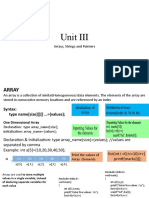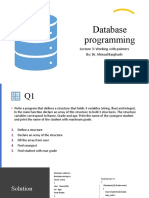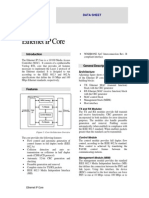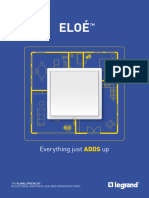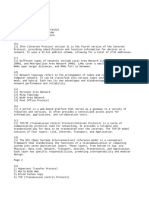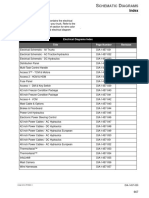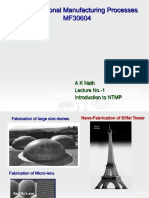0 ratings0% found this document useful (0 votes)
14 views3 pagesC Chota 1
The document provides various C programming examples and explanations, including finding GCD and LCM, dynamic memory allocation, string manipulation, and the differences between compilers and interpreters. It covers concepts such as arrays, pointers, user-defined functions, and memory management functions like malloc and calloc. Additionally, it discusses programming structures and advantages of structured programming.
Uploaded by
pewdiepienikalCopyright
© © All Rights Reserved
We take content rights seriously. If you suspect this is your content, claim it here.
Available Formats
Download as PDF, TXT or read online on Scribd
0 ratings0% found this document useful (0 votes)
14 views3 pagesC Chota 1
The document provides various C programming examples and explanations, including finding GCD and LCM, dynamic memory allocation, string manipulation, and the differences between compilers and interpreters. It covers concepts such as arrays, pointers, user-defined functions, and memory management functions like malloc and calloc. Additionally, it discusses programming structures and advantages of structured programming.
Uploaded by
pewdiepienikalCopyright
© © All Rights Reserved
We take content rights seriously. If you suspect this is your content, claim it here.
Available Formats
Download as PDF, TXT or read online on Scribd
You are on page 1/ 3
//Find GCD and LCM of two numbers given by the Read & Write int value Dinamic Memory
Read & Write int value Dinamic Memory Allocation:
user using recursion #include <stdio.h>
#include<stdio.h> #include <stdlib.h>
int GCD(int, int); int main() {
int main() int n;
{ int *arr;
int num1, num2, result_gcd; printf("Enter the number of integers: ");
printf("Enter first number : "); scanf("%d", &n);
scanf("%d", &num1); arr = (int *)malloc(n * sizeof(int));
printf("Enter second number : "); if (arr == NULL) {
scanf("%d", &num2); printf("Memory allocation failed. Exiting...\n");
result_gcd = GCD(num1, num2); return 1;
printf("GCD of %d and %d is %d\n", num1, num2, }
result_gcd); printf("Enter %d integers:\n", n);
return 0; for (int i = 0; i < n; i++) {
} scanf("%d", &arr[i]);
}
int GCD(int x, int y) printf("Entered integers are:\n");
{ for (int i = 0; i < n; i++) {
int rem; printf("%d ", arr[i]);
rem = x % y; }
if(rem == 0) printf("\n");
{ free(arr);
return y; return 0;
} }
else
{ What is an array?
return(GCD(y, rem)); An array is a data structure that stores elements of
} the same type in contiguous memory locations. It
} has a fixed size, and each element is accessed using
an index or subscript. Arrays are commonly used for
Pointer Function :- organizing and managing collections of data in
A pointer to a function is a variable that holds the programming.
memory address of a function in computer
programming. Instead of storing data, it stores the Find Reverse of a String :-
location in memory where a function is stored. This #include <stdio.h>
allows for dynamic function invocation and enables #include <string.h>
the flexibility to choose and execute different int main() {
//Cheak the year leap year or not
functions during runtime. Pointers to functions are char inputString[100];
#include<stdio.h>
commonly used for implementing callbacks, function printf("Enter a string: ");
int main()
tables, and achieving polymorphic behavior in fgets(inputString, sizeof(inputString), stdin);
{
programming languages that support them. int length = strlen(inputString) - 1;
int year;
for (int i = 0; i < length / 2; i++) {
printf("Enter the year to cheak leap year or not :
One Dimentional array using pointer :- char temp = inputString[i];
");
#include <stdio.h> inputString[i] = inputString[length - 1 - i];
scanf("%d", &year);
int main() { inputString[length - 1 - i] = temp;
int arr[5] = {10, 20, 30, 40, 50}; }
if(((year % 4) == 0 && (year % 100) != 0) || ((year
int *ptr = arr; printf("Reversed string: %s\n", inputString);
% 400) == 0))
printf("Accessing array elements using return 0;
{
pointers:\n"); }
printf("The year is leap year");
for (int i = 0; i < 5; i++) {
}
printf("Value at arr[%d] = %d\n", i, *ptr); *State advantages of an array*
else
ptr++; 1. Sequential and Random Access: Arrays allow both
{
} sequential and direct access to elements.
printf("The year is not leap year");
return 0; 2. Memory Efficiency:Fixed-size allocation leads to
}
} predictable memory usage and avoids
return 0;
fragmentation.
}
Write a program in C to check whether a number is 3. Simplicity: Arrays are easy to declare, use, and
divisible by 5 and 11 or not: understand.
Difference between Compiler and Interpreter:
#include <stdio.h> 4. Ease of Manipulation: Facilitates various
### Interpreter:
int main() { operations like sorting and searching.
- *Translation:* Translates code line-by-line during
int number; 5. Compact Code: Enables concise and readable code
runtime.
printf("Enter a number: "); through loop iterations.
- *Execution:* Executes code immediately without
scanf("%d", &number); 6. Compatibility with Algorithms: Suited for
creating a separate executable file.
if (number % 5 == 0 && number % 11 == 0) { implementing algorithms, especially in numerical
- *Speed:* Generally slower due to interpreting code
printf("%d is divisible by both 5 and 11.\n", processing.
during runtime.
number); 7. Ease of Parameter Passing: Arrays can be
- *Debugging:* Provides informative error messages
} else { efficiently passed as parameters to functions.
during runtime.
printf("%d is not divisible by both 5 and 11.\n",
- *Portability:* More portable as it doesn't produce
number); Storage Class :-
machine-specific executables.
} 1. auto : Default storage class for local variables
- *Edit-Run Cycle:* Shorter since changes can be
return 0; inside functions. Limited to the block in which it's
executed without a separate compilation step.
} declared.
### Compiler:
2. register : Suggests storing variables in CPU
- *Translation:* Translates the entire code into
Differentiate between call by value and call by registers for faster access. Its usage is a hint to the
machine code or an intermediate form beforehand.
address.: compiler.
- *Execution:* Produces a separate executable file
Call by Value: 3. static : Persists throughout the program
that can be run independently.
- Passes actual values. execution, retains its value between function calls,
- *Speed:* Faster execution as code is already
- Changes don't affect the original. and retains storage even after the block ends.
translated into machine code.
- Requires additional memory. 4. extern : Declares variables or functions defined in
- *Debugging:* May provide less informative error
other files, enabling access to them from the current
messages compared to interpreters.
Call by Address (Reference): file.
- *Portability:* Might need recompilation for
- Passes memory addresses.
different platforms.
- Changes affect the original.
- Edit-Run Cycle: Longer as it requires a separate
- No additional memory overhead.
compilation step after code changes.
String Handaling Functions :- Write a program in C to add two numbers using Write a program in C to find all prime numbers
1. String Copying Functions: pointers and function. between given interval using functions:
- strcpy: Copies one string to another. #include <stdio.h> #include <stdio.h>
2. String Concatenation Functions: int add(int *a, int *b); #include <stdbool.h>
- strcat: Concatenates two strings. int main() bool isPrime(int num) {
3. String Comparison Functions: { if (num <= 1) return false;
- strcmp: Compares two strings. int x, y, sum; for (int i = 2; i * i <= num; i++)
- strncmp: Compares a specified number of printf("Enter two numbers: "); if (num % i == 0) return false;
characters of two strings. scanf("%d%d", &x, &y); return true;
4. String Length Functions: sum = add(&x, &y); }
- strlen: Returns the length of a string. printf("The sum is %d\n", sum); void displayPrimesInInterval(int start, int end) {
5. String Searching Functions: return 0; printf("Prime numbers between %d and %d:\n",
- strstr: Finds the first occurrence of a substring in a } start, end);
string. int add(int *a, int *b) for (int i = start; i <= end; i++)
- strchr: Finds the first occurrence of a character in a { if (isPrime(i)) printf("%d\n", i);
string. return *a + *b; }
6. Other String Functions: } int main() {
- strncpy: Copies a specified number of characters int start, end;
from one string to another. Looping: printf("Enter start and end of the interval: ");
- strncat: Concatenates a specified number of In C programming, looping refers to the process of scanf("%d %d", &start, &end);
characters from one string to another. repeatedly executing a block of code as long as a displayPrimesInInterval(start, end);
- strtok: Splits a string into tokens based on specified certain condition is true. It allows the program to return 0;
delimiters. execute a set of statements multiple times, making }
- strspn: Returns the length of the initial segment of the code more efficient and reducing redundancy.
a string consisting entirely of characters from # Key Points about Loops in C :- Types of User-Defined-Function :-
another string. -Loops help in executing a block of code repetitively 1. No Return Value, No Arguments:
based on a specified condition. - Function doesn't return any value and doesn't
Write a C program to convert lowercase string to -They aid in controlling the flow of the program and take any arguments.
uppercase and vice versa. Do Not use string.h avoiding redundant code. 2. Return Value, No Arguments:
#include <stdio.h> -It's crucial to ensure that the loop's condition - Function returns a value but doesn't take any
void convertToLowercase(char str[]) { eventually becomes false to prevent infinite loops. arguments.
int i = 0; 3. No Return Value, With Arguments:
while (str[i] != '\0') { State advantages of using pointer in C : - Function doesn't return a value but takes
if (str[i] >= 'A' && str[i] <= 'Z') { Efficient Memory Management: arguments.
str[i] += 32; // Convert uppercase to Pointers enable direct access to memory, optimizing 4. Return Value, With Arguments:
lowercase usage. - Function both returns a value and takes
} Dynamic Memory Allocation: arguments.
i++; Allows dynamic memory allocation for flexibility.
} Passing Addresses as Function Arguments: Explain malloc with example:
} Enables functions to modify caller's variables. malloc() is a C function for dynamic memory
void convertToUppercase(char str[]) { Efficient Array Manipulation: allocation, allowing you to request a specific number
int i = 0; Supports direct array manipulation using pointers. of bytes in the heap at runtime. It returns a void*
while (str[i] != '\0') { Enhanced String Handling: pointer, which can be cast to the desired type.
if (str[i] >= 'a' && str[i] <= 'z') { Facilitates efficient string manipulation. Example:
str[i] -= 32; // Convert lowercase to #include <stdio.h>
uppercase Types of Arrays :- #include <stdlib.h>
} #Based on Dimensions: int main() {
i++; 1. One-dimensional Array: Linear collection of int dynamicArray = (int)malloc(5 * sizeof(int));
} elements accessed using a single index. if (dynamicArray != NULL) {
} 2. Multi-dimensional Array: Arrays with multiple free(dynamicArray); }
int main() { dimensions accessed using multiple indices. return 0;
char inputString[100]; #Based on Declaration: }
printf("Enter a string: "); 1. Static Array: Fixed size determined at compile-
gets(inputString); time. Explain calloc with example:
convertToUppercase(inputString); 2. Dynamic Array: Size determined at runtime using calloc() is a C function for dynamic memory
printf("Uppercase: %s\n", inputString); memory allocation functions. allocation that initializes allocated memory to zero.
convertToLowercase(inputString); #Based on Element Type: It takes two arguments: the number of elements to
printf("Lowercase: %s\n", inputString); 1. Homogeneous Array: Elements of the same data allocate and the size of each element in bytes.
return 0; type. Example:
} 2. Heterogeneous Array: Elements of different data #include <stdio.h>
types or structures. #include <stdlib.h>
Source vs Object :- int main() {
1. Nature: Write a program in C to find ASCII value of a int dynamicArray = (int)calloc(5, sizeof(int));
- Source code: Human-readable, written by character: if (dynamicArray != NULL) {
programmers. #include <stdio.h> free(dynamicArray); }
- Object code: Machine-readable, generated from int main() { return 0;
source code by compilers/assemblers. char character; }
2. Format: printf("Enter a character: ");
- Source code: Written in a high-level programming scanf("%c", &character); Advantages of Structured Program :-
language. printf("ASCII value of '%c' is %d\n", character, 1. Clarity and Readability: Clear, understandable
- Object code: Consists of binary/hexadecimal character); code structure.
instructions. return 0; 2. Modularity and Reusability: Breaks problems into
3. Readability: } manageable modules, promoting code reuse.
- Source code: Understandable by humans. 3. Ease of Maintenance: Easier to maintain and
- Object code: Not directly readable by humans. Sizeof() Operator :- update.
4. Usage: - sizeof() returns the size in bytes. 4. Debugging and Testing: Facilitates systematic
- Source code: Used for programming and - The result of sizeof() may vary depending on the debugging and testing.
modifications. compiler and system architecture. 5. Structured Control Flow: Enhances program
- Object code: An intermediate stage before - It's particularly useful for dynamic memory control and logic.
generating the final executable. allocation and determining the size of data 6. Reduction of Complexity: Organized code reduces
5. Execution: structures overall complexity.
- Source code: Needs compilation before Example :- sizeof(Expression); 7. Portability and Maintainability: More portable and
execution. easier to maintain.
- Object code: Requires linking or further 8. Structured Design: Promotes a systematic
processing to become an executable. approach to problem-solving.
Header File :- = vs == :- Source File vs Object File vs Binary Executable File :-
A C header file contains declarations of functions, = (Assignment Operator) is used to assign a value to # Source File :-
constants, and data types used in multiple program a variable, whereas == (Equality Operator) is used to - Contains human-readable code written in a
files. It allows sharing these declarations across compare whether two values are equal in a programming language (e.g., C, C++).
different parts of the program for code reusability condition. - Has file extensions like .c (C), .cpp (C++), or others.
and consistency. They are included using #include - Contains the program's logic and is editable by
and have a .h extension. Token :-
programmers.
Tokens in C are the smallest units of code, including
#Object File :-
What is C? keywords, identifiers, constants, operators, special
C is a powerful, versatile, and efficient programming symbols, and comments. They form the fundamental - Generated by compiling the source code using a
language known for its portability, direct hardware elements parsed by the compiler to understand the compiler.
access, and wide applicability in system software, program's structure. - Contains machine code and is not directly
embedded systems, and applications due to its rich executable by the CPU.
standard library and structured nature. Syntax Error :- - Includes translated code from the source file,
Syntax errors violate programming language rules, symbol table information, and references to external
Explain realloc with example: found by the compiler during compilation, stopping functions.
realloc() resizes dynamically allocated memory in C. code execution. Examples: missing punctuation, - File extensions might be .o (Unix-based systems) or
It takes a pointer to the original block and the new incorrect syntax, must fix for successful compilation. .obj (Windows).
size in bytes. Returns a pointer to the resized block. #Binary Executable File :-
If unsuccessful, returns NULL.
- Created by linking one or more object files
Example: '\0' Character :-
together, along with necessary libraries.
#include <stdio.h> The '\0' character marks the end of a string in
- Contains machine code directly executable by the
#include <stdlib.h> programming languages like C and C++, signaling
int main() { CPU.
where the string ends in memory.
int arr = (int)malloc(3 * sizeof(int)); - The final form of the program that users run.
arr = (int*)realloc(arr, 5 * sizeof(int)); - File formats differ based on the operating system,
<> vs " " :-
free(arr); such as .exe on Windows, no extension on Unix-
1. < > : Used for system header files. Compiler
return 0; based systems, etc.
searches in system directories.
}
2. " " : Used for user-defined or local header files.
Break vs Continue :-
Macros :- Compiler searches in the current directory or
1. *Exit Behavior* :-
Macros in C are preprocessor directives created specified directories.
- break: Terminates the loop entirely.
using #define. They define symbolic constants or - continue: Skips the current iteration, proceeding
code snippets that get replaced throughout the code Debugging :-
to the next.
before compilation. They improve code readability, Debugging is finding and fixing errors in code. It
2. *Loop Control* :-
aid in defining constants, and create reusable code involves identifying issues, locating their source,
fragments. - break: Exits the innermost loop.
making corrections, and ensuring the code
- continue: Skips the current iteration's code.
functions as expected.
Explain free with example: 3. *Execution Flow* :-
free() is a C function used to deallocate memory - break: Jumps to the code following the loop after
Library Function :-
allocated by malloc(), calloc(), or realloc(). It takes a termination.
Library functions in C are pre-written functions
pointer to the allocated memory as an argument. - continue: Continues with the next
available in libraries like standard ('stdio.h', 'stdlib.h')
Example: iteration of the loop.
or third-party. They perform specific tasks, aiding in
#include <stdio.h>
#include <stdlib.h> code reusability and saving time by providing ready-
String Functions :-
int main() { made solutions for common programming tasks.
1. strlen :- Calculates the length of a string.
int arr = (int)malloc(5 * sizeof(int));
2. strcmp :- Compares two strings lexically.
free(arr); Prototype Declaration :-
3. strcat :- Concatenates (appends) one string to
return 0; Function prototype in C declares the function's
another.
} signature (return type, name, parameter types)
4. strcpy :- Copies one string to another.
without its body. It enables the compiler to check for
Assembler :- errors during compilation and allows calling
Assembler in C translates assembly code to machine Array vs Pointer :-
functions before their actual definitions.
code for the computer's hardware, creating object #Arrays:
files for linking into executable programs. Advantages :-
What is Keywords :-
- Indexed access
Keywords are reserved words in programming
Typecasting :- - Fixed size
Typecasting, or type conversion, is the process of languages with predefined roles, controlling program
- Compile-time error checking
converting one data type into another. In C, it can be flow, data types, and structures. Examples: if, int,
Disadvantages :-
implicit (automatic) or explicit (done by the return. They define syntax and are crucial for
- Fixed size limitation
programmer using (type)value). It's crucial for code functionality.
- Lack of dynamic memory allocation
ensuring compatibility between different data types
- Pass-by-value in function calls
but may result in loss of precision or information. Avoid & Disadvantages goto() :-
Avoid goto in modern programming. Its
What is local and global veriable in C : #Pointers:
disadvantages include complex and less readable
Local Variables: Advantages :-
code, hindered debugging, violation of structured
Declared within a block (e.g., a function). - Dynamic memory allocation
programming principles, and potential unintended
Limited scope to the block. - Flexibility in memory addressing
side effects. Using structured alternatives enhances
Memory is allocated upon entering the block and - Pass-by-reference in function calls
code readability, organization, and reduces errors.
released upon exit. Disadvantages :-
Accessible only within the block. - Manual memory management
Global Variables: Break vs Continue :-
- Potential for memory errors
Declared outside of functions. 1. *Exit Behavior* :-
- Indirection complexity
Program-wide scope. - break: Terminates the loop entirely.
Memory is allocated at program start and released - continue: Skips the current iteration, proceeding
#Differences :-
at program end. to the next.
- Arrays store elements of the same type; pointers
Accessible from any part of the program. 2. *Loop Control* :-
Local variables are specific to a block, while global store memory addresses.
- break: Exits the innermost loop.
variables have a broader scope across the entire - Arrays have a fixed size; pointers can change
- continue: Skips the current iteration's code.
program. dynamically.
3. *Execution Flow* :-
- Arrays allow direct element access; pointers need
- break: Jumps to the code following the loop after
to be dereferenced to access data.
termination.
- continue: Continues with the next
iteration of the loop.
You might also like
- BERC 1313 Lab 5 POINTER - 2022 - 2023 - Sem2No ratings yetBERC 1313 Lab 5 POINTER - 2022 - 2023 - Sem215 pages
- Functions: What Is A Function? Block of Code Divide Code Reusability Readability MaintenanceNo ratings yetFunctions: What Is A Function? Block of Code Divide Code Reusability Readability Maintenance16 pages
- Introduction To Arrays: ESC101 September 6No ratings yetIntroduction To Arrays: ESC101 September 629 pages
- Unit 8 Pointers & Dynamic Memory AllocationNo ratings yetUnit 8 Pointers & Dynamic Memory Allocation12 pages
- A B+a B A-B A A-B 2) : 1) Swap Two Variables Without Using Third VariableNo ratings yetA B+a B A-B A A-B 2) : 1) Swap Two Variables Without Using Third Variable33 pages
- Why Doesn't C Support Function Overloading?No ratings yetWhy Doesn't C Support Function Overloading?17 pages
- CS 414/415 Section C For Java Programmers: Indranil GuptaNo ratings yetCS 414/415 Section C For Java Programmers: Indranil Gupta47 pages
- Unit III Pointers Part B and Dynamic Memory AllocationNo ratings yetUnit III Pointers Part B and Dynamic Memory Allocation24 pages
- C Arrays and Pointers: - in Java, Pointers Are Easy To Deal WithNo ratings yetC Arrays and Pointers: - in Java, Pointers Are Easy To Deal With16 pages
- Address in C: Reference Operator (&) and Dereference Operator ( )No ratings yetAddress in C: Reference Operator (&) and Dereference Operator ( )18 pages
- Department of Computer Science and Engineering Continuous Assesment Test-Iii - Answer Key GE6151-Computer ProgrammingNo ratings yetDepartment of Computer Science and Engineering Continuous Assesment Test-Iii - Answer Key GE6151-Computer Programming11 pages
- Dynamic Memory Allocation: Free. There Is Also Sizeof Function Used To Determine The Number ofNo ratings yetDynamic Memory Allocation: Free. There Is Also Sizeof Function Used To Determine The Number of9 pages
- Chapter 1 Notes (11 Files Merged) (1) - InvertNo ratings yetChapter 1 Notes (11 Files Merged) (1) - Invert19 pages
- C Arrays and Pointers: - in Java, Pointers Are Easy To Deal WithNo ratings yetC Arrays and Pointers: - in Java, Pointers Are Easy To Deal With38 pages
- 28V, 6.5A, Low Iq, Synchronous Buck Converter With 2-Bit VIDNo ratings yet28V, 6.5A, Low Iq, Synchronous Buck Converter With 2-Bit VID24 pages
- A Comparison of ISP and MNO Interconnection - CakmakNo ratings yetA Comparison of ISP and MNO Interconnection - Cakmak6 pages
- Patch and Settings Management in Microsoft System Center Configuration Manager 2012No ratings yetPatch and Settings Management in Microsoft System Center Configuration Manager 201236 pages
- ELOE Legrand Brochureكتلوج المفاتيح الجديدهNo ratings yetELOE Legrand Brochureكتلوج المفاتيح الجديده11 pages
- AUTONOMOUS B.Tech EEE R20 Course StructureNo ratings yetAUTONOMOUS B.Tech EEE R20 Course Structure8 pages
- Sensitivity Analysis for Decision MakersNo ratings yetSensitivity Analysis for Decision Makers14 pages
- Software Test Engineering Support in Dover NJ Resume David Strucko0% (1)Software Test Engineering Support in Dover NJ Resume David Strucko2 pages
- Non Traditional Manufacturing Processes Mf30604: Aknath Lecture No.-1 Introduction To NTMPNo ratings yetNon Traditional Manufacturing Processes Mf30604: Aknath Lecture No.-1 Introduction To NTMP12 pages











